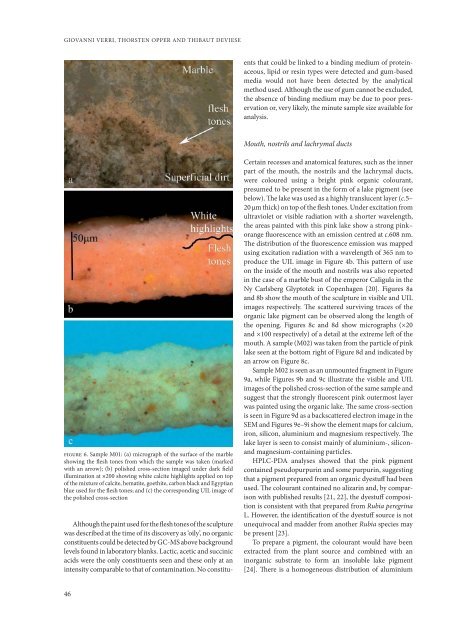Create successful ePaper yourself
Turn your PDF publications into a flip-book with our unique Google optimized e-Paper software.
GIOVANNI VERRI, THORSTEN OPPER AND THIBAUT DEVIESE<br />
figure 6. Sample M01: (a) micrograph of the surface of the marble<br />
showing the flesh tones from which the sample was taken (marked<br />
with an arrow); (b) polished cross-section imaged under dark field<br />
illumination at �200 showing white calcite highlights applied on top<br />
of the mixture of calcite, hematite, goethite, carbon black and Egyptian<br />
blue used for the flesh tones; and (c) the corresponding UIL image of<br />
the polished cross-section<br />
Although the paint used for the flesh tones of the sculpture<br />
was described at the time of its discovery as ‘oily’, no organic<br />
constituents could be detected by GC-MS above background<br />
levels found in laboratory blanks. Lactic, acetic and succinic<br />
acids were the only constituents seen and these only at an<br />
intensity comparable to that of contamination. No constitu-<br />
46<br />
ents that could be linked to a binding medium of proteinaceous,<br />
lipid or resin types were detected and gum-based<br />
media would not have been detected by the analytical<br />
method used. Although the use of gum cannot be excluded,<br />
the absence of binding medium may be due to poor preservation<br />
or, very likely, the minute sample size available for<br />
analysis.<br />
Mouth, nostrils and lachrymal ducts<br />
Certain recesses and anatomical features, such as the inner<br />
part of the mouth, the nostrils and the lachrymal ducts,<br />
were coloured using a bright pink organic colourant,<br />
presumed to be present in the form of a lake pigment (see<br />
below). <strong>The</strong> lake was used as a highly translucent layer (c.5–<br />
20 μm thick) on top of the flesh tones. Under excitation from<br />
ultraviolet or visible radiation with a shorter wavelength,<br />
the areas painted with this pink lake show a strong pink–<br />
orange fluorescence with an emission centred at c.608 nm.<br />
<strong>The</strong> distribution of the fluorescence emission was mapped<br />
using excitation radiation with a wavelength of 365 nm to<br />
produce the UIL image in Figure 4b. This pattern of use<br />
on the inside of the mouth and nostrils was also reported<br />
in the case of a marble bust of the emperor Caligula in the<br />
Ny Carlsberg Glyptotek in Copenhagen [20]. Figures 8a<br />
and 8b show the mouth of the sculpture in visible and UIL<br />
images respectively. <strong>The</strong> scattered surviving traces of the<br />
organic lake pigment can be observed along the length of<br />
the opening. Figures 8c and 8d show micrographs (×20<br />
and ×100 respectively) of a detail at the extreme left of the<br />
mouth. A sample (M02) was taken from the particle of pink<br />
lake seen at the bottom right of Figure 8d and indicated by<br />
an arrow on Figure 8c.<br />
Sample M02 is seen as an unmounted fragment in Figure<br />
9a, while Figures 9b and 9c illustrate the visible and UIL<br />
images of the polished cross-section of the same sample and<br />
suggest that the strongly fluorescent pink outermost layer<br />
was painted using the organic lake. <strong>The</strong> same cross-section<br />
is seen in Figure 9d as a backscattered electron image in the<br />
SEM and Figures 9e–9i show the element maps for calcium,<br />
iron, silicon, aluminium and magnesium respectively. <strong>The</strong><br />
lake layer is seen to consist mainly of aluminium-, silicon-<br />
and magnesium-containing particles.<br />
HPLC-PDA analyses showed that the pink pigment<br />
contained pseudopurpurin and some purpurin, suggesting<br />
that a pigment prepared from an organic dyestuff had been<br />
used. <strong>The</strong> colourant contained no alizarin and, by comparison<br />
with published results [21, 22], the dyestuff composition<br />
is consistent with that prepared from Rubia peregrina<br />
L. However, the identification of the dyestuff source is not<br />
unequivocal and madder from another Rubia species may<br />
be present [23].<br />
To prepare a pigment, the colourant would have been<br />
extracted from the plant source and combined with an<br />
inorganic substrate to form an insoluble lake pigment<br />
[24]. <strong>The</strong>re is a homogeneous distribution of aluminium

















